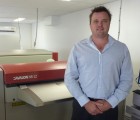
As commercial print sell prices remain low and printers have trouble moving them upwards, the available options for increasing margins dwindle quickly. Pundits say the collapse of Focus Press was partly due to it finding itself trapped in a downward price spiral. The company tried to raise prices and its customers looked elsewhere.
There are other similar GFC war stories in the Australian print marketplace, where quality is now no longer the only criterion on which a provider is selected. Today, it has to be on time, in just the right quantities – and at a competitive price. It’s the minimum a printer can do to stay competitive.
Of course, the only certain way to increase margins is to reduce costs, and the best way to do this is through automation. Vendor-supplied workflow software has been on the market for some 20 years now, beginning in the offset realm with PDFs, digital proofing, later soft proofing, and CTP regimes that automated the platemaking process.
In the front office, management information systems (MIS) began replacing sales reps’ scratchpads and calculators. Then came XML language for online data transfer and with it, Job Definition Format/Job Manufacturing Format (JDF/JMF) and the global CIP4 platform, hailed as a way to send information upstream and downstream and eliminate double handling. JDF has now matured to facilitate hybrid offset/ digital workflows. Automation has extended to ‘fingerprinting’ the offset presses, and the AS/ISO 12647-2 colour platform.
Vendor workflows, such as Kodak Prinergy, Heidelberg Prinect, Fujifilm XMF and Agfa Apogee, are a far cry now from their 1990s antecedents, the litho-plate enablers that replaced film and imagesetters, and today’s workflow products are built to identify the optimal output choice, regardless of the technology. With the meteoric graduation of digital presses from souped-up copiers to fully fledged printshop workhorses, workflow products began integrating these machines. Then came onboard inline finishing and offline dedicated digital bindery gear.
The underlying philosophy is that the fewer human touchpoints in the workflow the better, as manual intervention slows the process, leads to mistakes, and is expensive. By contrast, automating the workflow eliminates mistakes, is cheap and enables great efficiencies.
Yet perhaps the greatest breakthrough came with the utilisation of the web as a portal to an unbounded marketplace. With online ordering, local and regional printers have discovered national markets, even international ones.
Hooking web-to-print (W2P) gateways into the MIS and subsequently into the digital pressroom and bindery is seen by some pundits as the ultimate masterstroke. And it isn’t the Holy Grail – it is achievable and it is being achieved in Australia today.
Peter Britliff, marketing manager, software, at Fuji Xerox Australia, says that technically it is possible to automate an order through to fulfilment, but most printers have implemented automation in silos and have not yet realised the full savings available. He says, “Printers may have made progress in job submission (W2P/MIS), but this isn’t linked well into shopfloor pre-production processes. Most still leverage a complex array of hot-folders to automate prepress tasks and manually rekey order information between job submission/ticketing, estimation/ quotation, prepress and finishing.”
Fuji Xerox offers its FreeFlow Core, a browser-based workflow solution that automates and integrates the processing of print jobs, from file preparation to final production. Britliff says implementation is straightforward. “Most if not all DFEs come standard with hot-folder or virtual printer technology, yet many printers don’t even use this basic functionality. Many printers state that every job is different, but even automating one or two regular jobs will immediately free up operators and staff to work on more complex prepress tasks or better yet sell more profitable work. My tip is to work towards the 80:20 rule. Automate 80 per cent of the regular repeat job types to give you and your business more time to win new profitable business. A rules-based automated workflow solution will allow you to streamline operations intelligently, not just hot-folders.”
David Procter, general manager, production printing at Konica Minolta Australia, says removing human touchpoints, increasing accuracy, ganging up multiple jobs and speeding up the turnaround of jobs is critical. In terms of its offering to the marketplace, Konica Minolta is taking a different approach. Rather than a proprietary solution, it works with industry partners to offer what Procter calls a vendor-neutral alternative, with products for entry-level, expanding and mature environments. He says, “The reduction of touchpoints should allow more time for the management of quality.”
How easy to implement? That depends, says Procter. “It can be very simple for an ‘out-of-the-Cloud’ solution, or quite intense for a bespoke experience.” Konica Minolta’s national workflow manager Matt Hunter advises print enterprises to consider their human resources at this point. “Keep in mind that typically your staff are one of the key success factors,” he
tells ProPrint. “It is important to identify an internal champion and manage the change management, making sure everyone knows why you are doing it, and how it affects them.”
Intelligent impositioning should be a key aspect of an automated workflow, says Britliff. “The basic two-up on a single sheet of paper will immediately halve your digital copy cost. Ganging jobs will further reduce material costs and is essential in the larger-format offset or wide-format worlds, but in small format digital the return is minimal. The biggest cost savings come from automating repetitive tasks with rules-based automation.” Britliff quotes the IBIS World C2412 Printing in Australia Industry Report, in saying that more than a quarter of the printing industry’s costs are directly attributed to wages and salaries, so by reducing manual labour, automation can save a business in time, money and waste.
Says Konica Minolta’s David Procter: “Every digital printer should be using impositioning software, such as for business cards, flyers and so on. Within digital, the ganging up of work is less than offset due to it being limited to SRA3 currently.”
Frontline Printing at Artarmon in Sydney’s north is celebrating its 30th anniversary this year, and managing director Wayne Godsell reflects to ProPrint that this milestone may not even have been achieved if the company had not responded vigorously and positively to the challenges of the GFC. Godsell describes the 2008-11 global downturn as the greatest challenge he has experienced in 30 years in the trade. And he attributes Frontline’s present-day prosperity to a decision to plug in to web sales of print jobs.
In 2011, Frontline installed Qprint Pro, a US-developed W2P portal from MIS vendor Quote & Print, to fling open its doors to the market at large. From localised Sydney sales, Frontline’s catchment area has now become national, and Godsell reports that roughly 30-40 per cent of sales are now online, and he expects that rate to continue over the next three years.
The Qprint Pro integrates with the Q&P MIS and with Frontline’s Konica Minolta bizhubs – an 8000, a 6500, a 1021 mono, and a 65HC (high corona) press that prints direct from RGB files and is able to produce fluorescent colours. (The company also runs Océ cutsheet presses, Roland and Canon wide-format presses and flexo presses and hot foilers for label printing from Rotary Engineering and Rapid Machinery).
Says Godsell: “When an order is placed, the payment is made online by credit card, the order is linked into the Q&P MIS, so that a job sheet is created. The customer is set up in Q&P automatically. We also have their artwork ready to download and be proofed online, and a job sheet is printed out.
“The instructions for printing and finishing are all there on the job sheet. With the job sheet, the artwork approval sheet is printed out at the same time. The bindery can see trim marks, registration and everything they need to complete the job. Much of our finishing is inline, one-pass, through the Konica Minolta presses, such as the Bookletmaker on the 8000.”
One of the great advantages of all this automation is that, in most cases, the prepress department can be bypassed, as subsequent orders from that customer can be stored as templates produced by Qprint Pro’s eDesigner, that are modified and sent direct to the bizhub operators who send the artwork straight to print, relieving the prepress department of the arduous tasks of reinventing the wheel.
Customers, such as Scouts Australia, can dial in, call up their templates for business cards, posters, brochures or invitations, rework them and upload them as they place their new order.
Godsell estimates that before W2P came to Frontline, providing finished artwork with each order, multiple handled work accounted for about 50 per cent of the graphics operators’ workload, that has now gone.
Godsell makes the point that as effective as lowering his cost margins has proven, it is actually the uptick in sales, and the migration of many existing sales online, that has revolutionised Frontline’s earnings.
He recalls baulking at the $26,000 initial set-up cost of the intelligent website, but estimates that the Qprint Pro system paid for itself in about the first month of operation.
“A lot of our business begins with Google. People find our website, looking for a product, then see other products they can use. Our greatest example of this is a customer who came to us online for a single sale and has so far purchased around $450,000 worth of printing,” he says.
Comment below to have your say on this story.
If you have a news story or tip-off, get in touch at editorial@sprinter.com.au.
Sign up to the Sprinter newsletter


